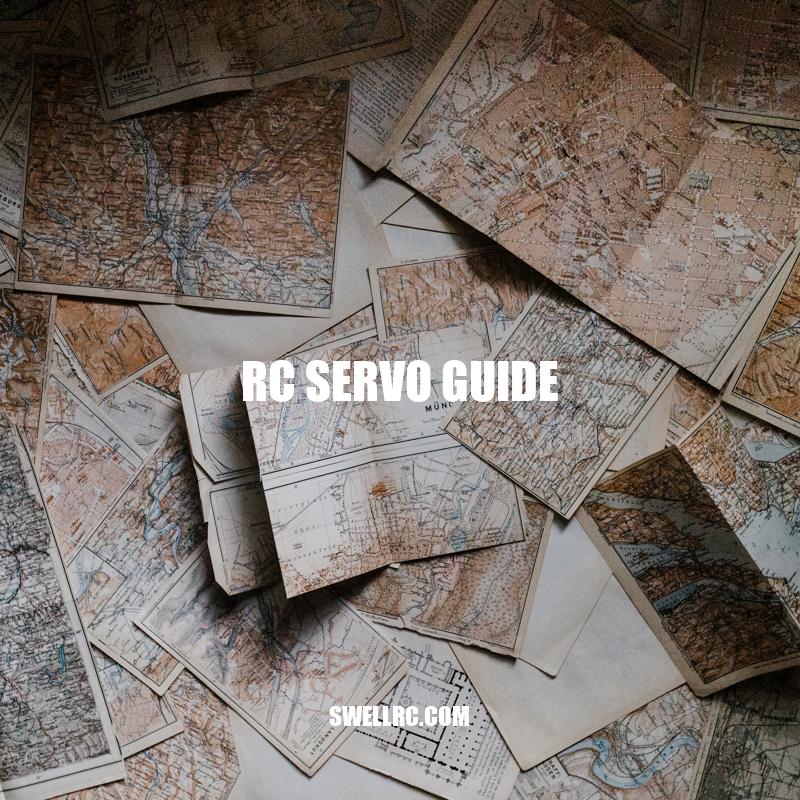Ultimate RC Servo Guide: Types, Features, Choosing, Maintaining and Troubleshooting
RC or radio control servos are small actuators typically used in radio-controlled models or toys. They are responsible for transforming electrical signals from the controller into mechanical movements, such as moving the steering mechanism on a remote-controlled car or operating the flaps on a radio-controlled airplane. RC servos consist of an electric motor, gearbox, and output shaft, all encased in a plastic or metal housing. There are different types of RC servos available, including digital and analog servos. Digital servos provide faster and smoother movements and are ideal for high-performance models, while analog servos offer cost-effective and straightforward positioning. Additionally, RC servos come in various sizes, with different torque and speed ratings, and can be complex or straightforward depending on the application. Knowing the right type of servo to use for a particular model is essential for the success of the project. This guide covers the essential features of RC servos, how to choose the right one, and tips for maintaining them.
Key Features of RC Servos
When looking for an RC servo, some essential features must be kept in mind. These include:
Torque Rating
– Torque rating is the force that the servo can output.
– High torque rating is required for heavy applications, while low torque rating servos are ideal for smaller models.
– Servos can have torque ratings that range from a few ounces to tens of thousands of ounces.
Speed Rating
– Speed rating is the time taken by the servo to cover a specific distance.
– High-speed servos are common in fast-moving applications, while slower ones are typical in slow-moving applications.
– Speed rating is expressed in seconds/60 degrees or seconds/90 degrees.
Analog or Digital Servo
– Analog and digital servos are the two main types of RC servos.
– Analog servos are simpler and less expensive, and they move in proportion to the control signal received.
– Digital servos are more advanced and have better resolution and accuracy. They can handle higher torques, provide more precise control and faster response time, but are more expensive than analog servos.
Knowing the features of the RC servo to look for can be confusing. Luckily, there are several websites out there that can make the process more manageable. For example, ServoCity.com provides a wide range of RC servos to choose from. They offer servos that can handle various applications and provide a servo selector tool on their website. They also have experts available to help answer any questions you may have about the best servo for your projects.
What is the feature of servo?
Some key features of servo motors include:
- Precision control of angular position, velocity, and acceleration
- High torque-to-inertia ratio
- High torque-to-weight ratio
- Quick response to changes in the control signal
- High accuracy and repeatability
- Low maintenance
If you’re interested in learning more about servo motors and their applications, there are many websites and products available that can provide in-depth information and resources. Some popular options include Servo Magazine, ServoCity, and the Arduino website’s section on Servo Motors.
Body of the RC Servo
The build of the RC servo is an essential aspect to ensure it can handle the workload required of it.
Material used
The body of the servo can be made of industrial-grade plastic or metal. Metal gears can improve the strength of the gear train and prolong the lifespan of the servo.
Dimensions and Gear Ratio
RC servos come in various sizes, weight and gear ratios. It’s essential to select the size and gear ratio of the servo based on the specific application. A higher gear ratio means that the gears will rotate multiple times, producing more torque. Below is a comparison table of different sizes of RC servos and their technical specifications:
| Size | Weight (g) | Torque (kg-cm) | Speed (sec/60°) |
|---|---|---|---|
| Micro | ≤10 | ≤1 | ≤0.15 |
| Mini | 10-25 | 1-2 | 0.15-0.3 |
| Standard | 25-50 | 2-5 | 0.3-0.5 |
| Large | 50-100 | 5-15 | 0.5-0.8 |
Some RC servo brands have earned their reputation, such as Futaba, which is one of the most well-known brands in the industry. It has been manufacturing servos since the early 60s and now provides a wide range of premium-quality RC servos trusted by hobbyists and enthusiasts worldwide.
What is the size of a standard RC servo?
Here are the standard sizes for RC servos:
- Standard size: 40 x 20 x 36mm
- Mini size: 30 x 10 x 34mm
- Micro size: 23 x 12 x 27mm
For more information on RC servos, visit websites such as Horizon Hobby or Tower Hobbies.
Choosing the Right RC Servo
Selecting the right RC servo can significantly impact the performance of your device. Here are a few things to keep in mind while making your decision:
Torque Rating
The torque rating determines the amount of force output by the servo. It’s crucial to select the appropriate torque rating, as too little can cause the device to function less effectively, while too much can lead to damage.
Size and Dimensions
The size and dimensions of the servo depend on the application of the device. Ensure you select the appropriate size to prevent issues like overheating or insufficient power supply.
Analog or Digital Servo
The choice between analog or digital servo depends on your specific needs. Analog servos are cheaper, but digital servos offer greater precision and have a faster response time.
There are many choices of RC servo brands and models available today. Websites such as Amazon have a wide selection of servos from various brands, including Futaba, Hitec, and Traxxas. Make sure to read expert reviews and consider the features of each servo before making a purchase.
What factors should you consider when selecting a servo motor?
When selecting a servo motor, there are several factors that you need to consider to ensure that the motor perfectly fits your requirements. These include:
- Motor specifications: Consider the motor’s torque, speed, and power rating, which dictate its performance.
- Application requirements: Make sure the motor can handle the unique demands and conditions of your application, such as environmental factors, load type, and duty cycle.
- Feedback device: Determine the best feedback device for your application, such as encoder or resolver.
- Communication protocols: Ensure that the motor’s communication protocols are compatible with the rest of your system.
Several websites offer a wide range of servo motors with different specifications and features, including Motion Control Products Ltd, Applied Motion Products, and Delta Electronics. Consider consulting with these websites to make the right decision.
Maintaining RC Servos
To prolong the lifespan of your RC servos, proper maintenance is essential. Here are a few tips to keep your servos in top condition:
Prevent Moisture Buildup
Moisture can cause corrosion and damage to the metal parts of your servo. Keep your servos dry and away from damp areas.
Proper Storage
The way you store your servos can affect their performance. It’s best to store them in a dry and cool place, and protect them from physical damage. You can use protective cases to store multiple servos.
Lubrication
Gears are the most crucial part of your servo system, and lubrication can help maintain their efficiency. Use a high-quality lubricant on the gears and ensure that it doesn’t get on any electronic components.
Regular Inspection
Inspecting your servos regularly can help you identify any issues before they become significant problems. Check for any visible damages, loose screws, or worn-out gears. If you find anything, address it immediately.
Many online retailers like HobbyKing, Tower Hobbies, and AMain Hobbies offer a wide variety of maintenance supplies for your RC servos. Make sure to read expert reviews and consider the features of each product before making a purchase.
How long does an RC servo last?
RC servos are designed to have a long lifespan with continuous use. However, the lifespan can vary depending on factors such as the quality of the servo, the manufacturer, maintenance, and usage. Here are some general guidelines on how long you can expect an RC servo to last:
- Low-end, low-quality RC servos may only last a few hours of use before failing.
- Average RC servos can last anywhere from 100 to 300 hours of continuous use.
- High-end, high-quality RC servos can last up to 1000 hours or more of continuous use.
- Maintenance plays a crucial role in the lifespan of an RC servo. Regular cleaning, lubrication, and tightening of screws can help prolong the lifespan of an RC servo.
It’s important to keep in mind that these are general guidelines and not a one-size-fits-all answer. To get the most out of your RC servo, it’s recommended to follow the manufacturer’s instructions and use it within its intended limits. Some popular websites for purchasing RC servos include Amazon, Tower Hobbies, and HobbyKing.
Troubleshooting Common Issues
Even with proper maintenance, RC servo systems can face issues. Here are some of the most common problems and how to address them:
Servo Twitching
– Check if the servo is receiving adequate power.
– Ensure the signal wire is correctly connected to the receiver.
– If using multiple servos, check if they’re connected properly to the receiver.
Servo Not Moving
– Check the wiring and ensure that they’re connected correctly.
– Verify if the receiver is functioning correctly.
– Check if the transmitter is correctly bound to the receiver.
Overheating of the Servo
– Reduce the load on the servo if it’s performing a strenuous task.
– Ensure that your device is receiving adequate cooling.
– If using multiple servos, distribute the load equally.
If you’re still facing issues, expert help might be necessary. Many hobby shops offer repair services for RC servo systems, and websites like RCGroups and RC Universe have active forums where you can ask for help from the RC community.
What is the problem of servo motor?
Some common problems with servo motors include:
- Overheating
- Motor not starting or turning
- Inaccurate positioning
- Excessive noise
- Interference with other equipment
If you are experiencing any of these issues with your servo motor, it is important to seek help from a professional. Some websites that provide helpful tips and troubleshooting methods for servo motors include Motion Control Online and Machine Design. You may also want to consider investing in a high-quality servo motor from reputable brands like Yaskawa or Siemens to minimize the risk of issues.
Conclusion
RC servos are critical components of radio-controlled devices, and their proper selection and maintenance can significantly affect the performance and longevity of your device. When picking an RC servo, consider its torque, speed rating, build quality, and digital/analog types. Regular maintenance such as keeping the servo dry, lubricating its gears, and storing it properly can also prolong its lifespan.
If facing issues with your servo, troubleshoot the problems or seek expert help. Hobby shops and online forums are excellent resources to find assistance. By following this RC servo guide, you will be able to choose, maintain, and troubleshoot RC servos effectively.
Overall, RC servos are fascinating and complex devices, and their proper functioning can determine the results of your RC project. As an RC enthusiast, investing in quality servos and maintaining them well should always be a priority.



